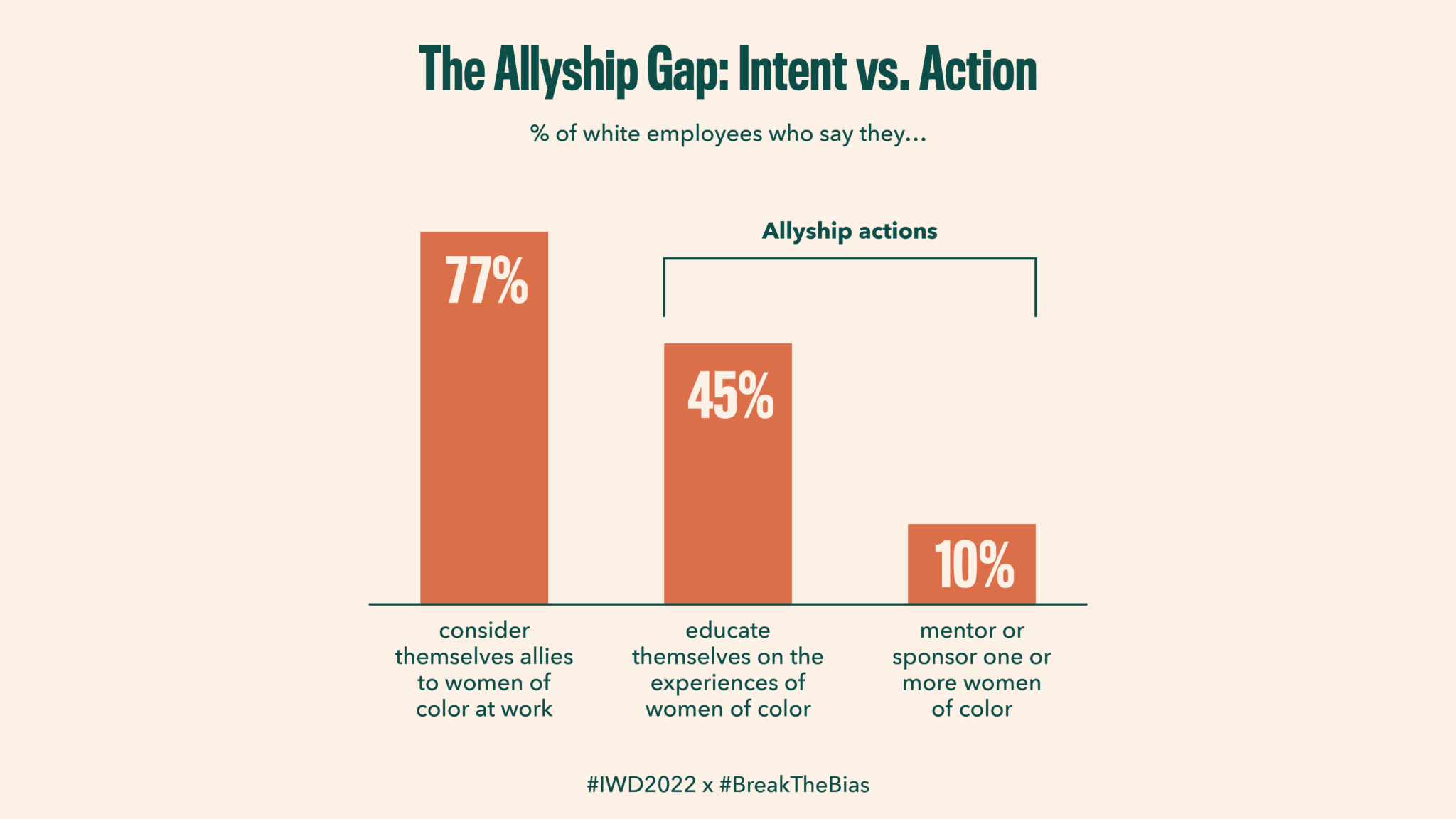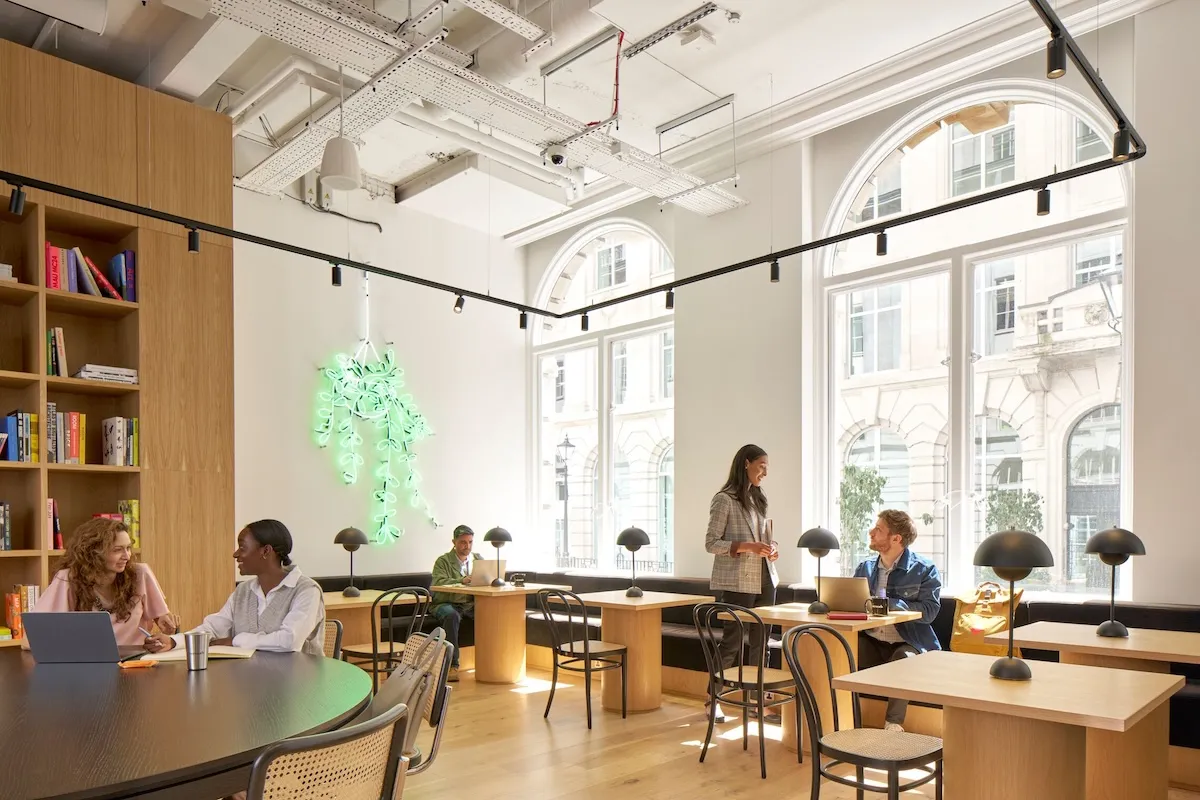Practicing allyship is one of the best things every one of us can do as individuals and as leaders—not only to reflect our personal values but also as a way to attract, develop, engage, retain, and advance top talent in our business.
At a recent WeWork event, LJ Louis, chief talent and inclusion officer at WeWork, sat down with Rachel Thomas, cofounder and CEO of LeanIn.org. Under Thomas’ leadership, Lean In has become a go-to resource for original research and data-backed tools to dismantle systemic bias at work. Thomas shared findings from Lean In and McKinsey’s annual 2021 Women in the Workplace report—the largest study on the state of women in corporate America—as well as specific ways to practice effective allyship, and how doing that will lift us all up, at work and beyond. Here are some takeaways from the discussion.
There’s more work to be done for women and people of color
Women were even more burned out in 2021 than they were in 2020, according to the latest Women in the Workplace study, which included 65,000 employees in corporate workplaces. In 2021, 42 percent of women said they were almost always burned out at work—up from the low 30s the year before. “People of all genders are burned out, but when you really look at the data, women are markedly more burned out than men,” Thomas said.
In a truly inclusive workplace, we all feel safe, we feel included, we feel like our ideas and our contributions are valued.
Rachel Thomas, cofounder and CEO of LeanIn.org
On top of that, even in the wake of the calls for racial justice and equality that seemed pervasive in 2020, she says, “the day-to-day experiences of women of color are, by and large, not improving. Women of color are facing the same types of microaggressions, with the same frequency, as they did a few years ago. We see no change in the data.”
Until people stop being surprised by a female coworker’s language skills or abilities (which happens three times more often to Latina women than to white women), and stop mistaking one female colleague for another (which happens four times more often to Black and Asian women than to others), and stop including personal style feedback during performance reviews (which happens to 66 percent of women versus to one percent of men), it’s very difficult to claim that the culture of work has improved in any meaningful way.
Identifying bias is the first step in eliminating it
Aside from microaggressions, Thomas identified three other major everyday biases that impact women: the gender pay gap and the glass ceiling—or even just a broken rung.
“In this country, if you control for geography, industry, level of education, and type of role, there is still a gender pay gap,” she said. “And while we’ve seen some modest but important progress with the glass ceiling, what’s more concerning is what we call the ‘broken rung.’”
Research has shown that in the first step up from entry level to manager, only 86 women get that promotion for every 100 men who do. “That means you end up with roughly two thirds of managers being men and one third of managers being women,” Thomas said. “So in every level there are fewer women to promote.” Even that first rung on the ladder of success is broken.
“One of our big messages to organizations is, if you want to have sustained progress in your pipeline, you’ve got to find where your broken rung is and put a laser focus on it,” she said. “We all need to do better.”
Allyship benefits everyone—not just those who are marginalized
There is a big gap between intending to be an ally and taking action, Thomas said. “We know that a huge majority of white employees see themselves as allies to women of color, for example. But when we ask people about specific actions of allyship—like speaking out publicly on behalf of racial equity in your organization, or mentoring and sponsoring a woman of color—the numbers drop like a rock.”
Yet speaking up and taking action has multiple benefits. “When you speak up in the moment on behalf of a colleague, research shows your stature in the group rises—so showing up as an ally and interrupting bias is good for you, too,” she says.
What’s more, these anti-bias actions actually inspire better behavior from the people witnessing the moment. “They go, ‘Well, I can do that too’—so allyship literally begets allyship,” she said.
Given the importance of allyship, and the persistence of the allyship gap, WeWork has dubbed 2022 the Year of Allyship. As part of this, WeWork will bring Lean In’s Allyship at Work learning program—a deep dive into how colleagues can be better allies—to WeWork colleagues around the world.
“We know that allyship enables every employee to come to work as their authentic self and be supported,” said Louis. “As a company, WeWork remains committed to fostering an environment where all individuals of every background and identity are welcomed, included, and valued.”
This is what being an ally looks and sounds like
Thomas suggests keeping three different strategies in mind for when you find yourself in a position to be an ally: Ask the probing question, get back to the facts, and speak up in the moment.
“If someone says, ‘I just don’t think she has leadership qualities,’ you might say, ‘Wow, that’s really interesting. Could you share a couple of examples of when you’ve seen that?’ ” she said. “Just that very question, research shows, forces the person to kind of step back and think about how they got to that assumption. And when you’re asked to justify your thinking, that also helps surface biases.”

“Another way to challenge bias is to get back to the facts,” she said. “So when you’re told a colleague just doesn’t seem like a leader, ask if they’ve looked at past performance reviews, or what her team says about how effectively she’s hitting her goals—all the things that you’d expect from a leader.”
Finally, it’s important to look for opportunities to speak up when you see something you don’t like. “In meetings, women are more likely to be interrupted or spoken over or have an idea stolen—where someone with more power or a louder voice takes her idea and runs with it,” she said. “When you see this happening, say, ‘LJ, that was great—I’d love to hear a little bit more about that idea of yours,’ or, ‘I’d love to hear LJ finish what she was saying.’ ”
How to really bring equity to the future of work
Organizations’ nimble reactions to the pandemic have made Thomas optimistic. “Look at what organizations could do when they had to,” she said. “My next challenge to them is let’s start treating DEI like the must-have it is. Imagine the amazing things that can happen if we do that.”
“With the shift to hybrid work, it is going to require a lot of intentionality to make sure the culture of an organization stays healthy and effective,” Thomas continued. “I’m hopeful that that intentionality will also help us really advance diversity, equity, and inclusion. I want to make sure that we don’t inadvertently create two classes of employees: those that are at home, and those that are in the office.”
“If you’re in the office, you have more access to senior leaders, you get more watercooler talk, you feel more connected,” she said. “If you’re at home, there’s so much benefit that comes with that, but will you be seen as out of sight, out of mind? Particularly because women are more likely to take advantage of flexibility.”
“In a truly inclusive workplace, we all feel safe, we feel included, we feel like our ideas and our contributions are valued,” Thomas said. “It’s about who’s at the table, but also how are we treating everybody there? Organizations need to lean into inclusion and create a workplace where all of those diverse voices actually feel welcome.”
Melanie Mannarino is a writer, editor, digital strategist, and author of several books, including The (Almost) Zero Waste Guide.
Rethinking your workspace?










